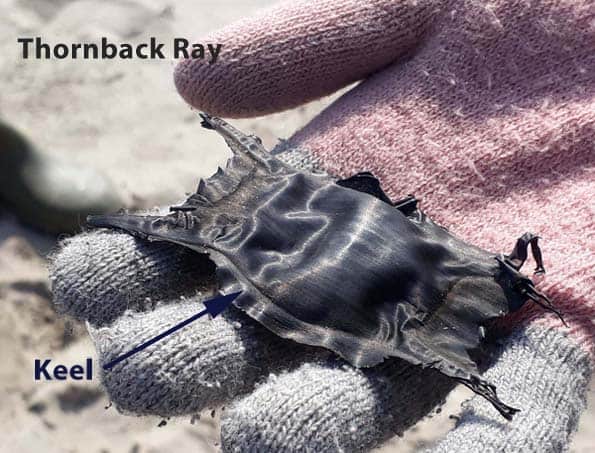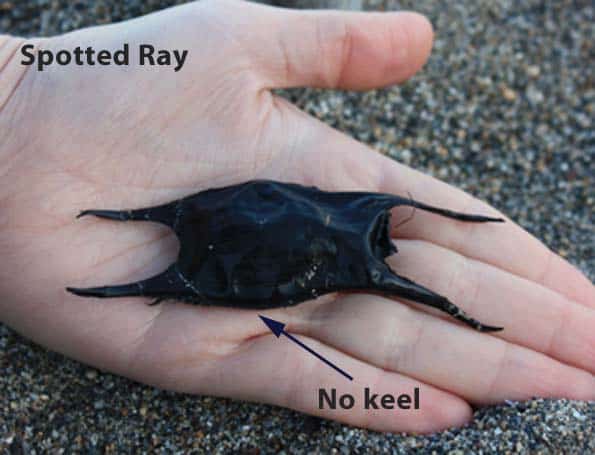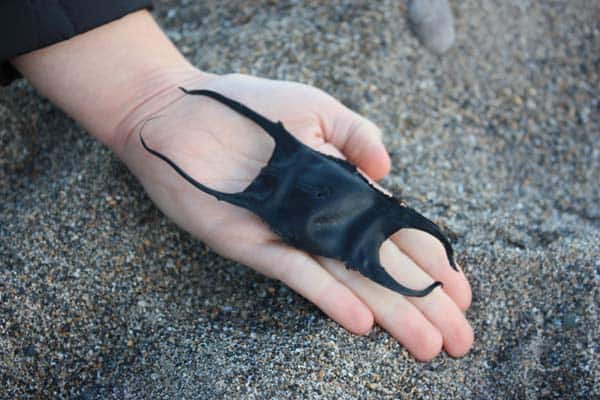
Collecting and identifying mermaids’ purses on the shoreline can be a fun activity for the whole family, and although some skate and ray eggcases can be difficult to identify, there are a number of species that can be easily recognized without the eye of a specialist.
In fact, mermaid’s purse spotting is fast becoming a popular beachcombing activity around the world, with citizen scientists discovering new nursery areas for threatened species of shark and ray in places we never knew existed!
If you would like to learn how to identify a mermaid’s purse, we recommend you take the following steps:
Step 1: Gather the tools that will help you to examine the eggcase more closely.
Step 2: Get to know the size, shape and form of the eggcase so that you can describe it effectively.
Step 3: Find a species identification guide or key that is right for you and your region so that you can match your eggcase with the correct description.
Step 4: Verify your species ID by sending your results to marine biologists in a local mermaid’s purse sightings scheme.
Step 1: Gathering the eggcase examination tools
If possible, have the following tools handy while you are examining your eggcase as they will help you to identify your mermaid’s purse to species level, especially while you are learning.
- Ruler or measuring tape
- Bowl of water (tap water or seawater, either will do)
- Notepaper and pen
- Camera
Ruler or measuring tape
It’s important to be able to measure the length of the eggcase as some species look similar in shape and form but differ in size.
If you are out in the field and don’t have a ruler, don’t worry as you can use a reference to an object that has a standard size. For example, a photograph of an eggcase along side an adult’s foot or hand can provide an indication of length.
A Small Spotted Catshark eggcase (also known as the Lesser Spotted Dogfish, Scyliorhinus canicula) is roughly the length of an adult’s little finger or pinky, whereas a Bull Huss catshark’s eggcase (also known as the Nursehound or Greater Spotted Dogfish, Scyliorhinus stellaris) is much larger and runs the length of an adult’s middle finger.
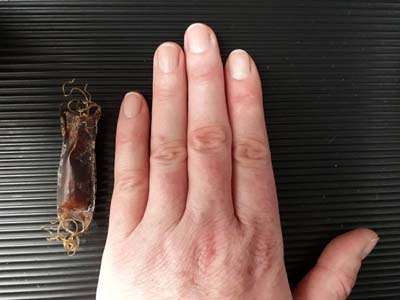
Small Spotted Catshark eggcase 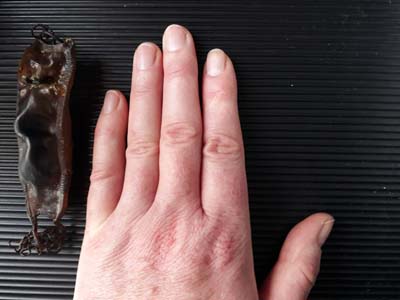
Bull Huss eggcase
Bowl of water
The Shark Trust recommend that you soak the mermaids’ purses in water for a couple of hours before examining them, as it can be easier to view the eggcase features this way. This is especially useful if you are finding it difficult to confirm species identification for eggcases that are damaged or in bad condition.
You’ll see that the eggcase expands quite a bit once it has been soaked and the features appear more well defined. The capsule will also feel softer and more pliable.
Once you have become more experienced and have identified numerous shark and skate species, you’ll probably find that you won’t need to soak the eggcases very often as you’ll be able to identify species more easily.
Notepaper and pen
It’s useful to record your observations on paper, although you can also make a note on a smartphone if you prefer. Make sure that you keep a back up of your records though if you’re using a smartphone, either on a digital cloud or as a hard copy. This is especially important if you’re keeping detailed records of eggcase numbers for a citizen science survey.
Camera
It’s helpful to have a photograph of the eggcase that you can use as a reference later on. It will help you to recognize the species if you see it again when beachcombing. You’ll also need to send a photograph of the eggcase to marine biologists if you would like to verify your species identification with a local mermaid’s purse sightings scheme.
Step 2: Getting to know the size, shape and form of the eggcase
When you are learning how to identify mermaids’ purses, you will first need to become familiar with their shape, size and form, as these are the features that we use to distinguish species.
Take a look at the diagram below which shows the shape and structure of a typical eggcase:
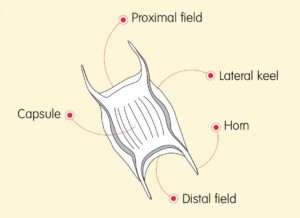
You’ll see that the pod has some distinctive features, some of which appear to be quite technical, but don’t worry too much about this as the biology is really very simple. There are just a few scientific terms to learn and these are translated and explained below.
Eggcase horns and tendrils
The first thing to note are the horns and/or tendrils on the eggcase as these can be used to distinguish the difference between purses laid by egglaying rays, skates and sharks.
If the egg has been produced by a skate or ray, you’ll generally see two spikes or horns at either end of the central capsule (where the embryo is housed). These are used to anchor the purse in the soft seafloor nursery habitat of the flat sharks and rays.
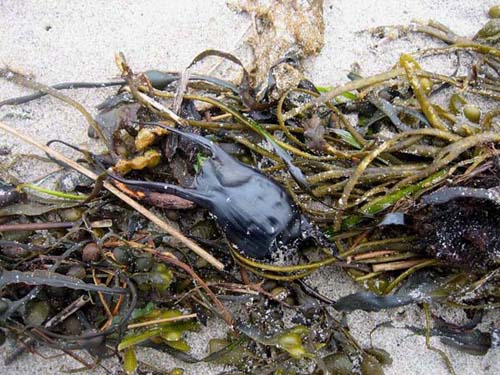
A Spotted Ray eggcase (Raja montagui). Photo credit: Sarah Varian
If the mermaid’s purse has been laid by a shark (eg. a Catshark, Swell Shark or Horn Shark), the eggcase is more likely to possess curly tendrils that can be used to wrap around seaweed fronds.
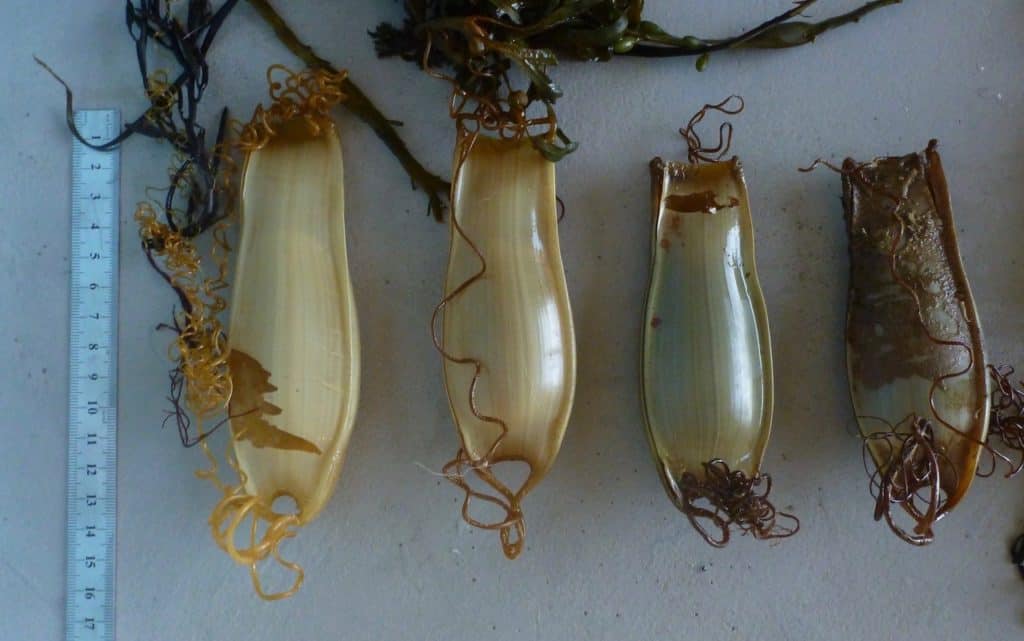
Bull Huss (Scyliorhinus stellaris) catshark eggcases. Photo credit: Sabine Springer
This allows the female to securely attach the egg to seaweed in rocky shore shark nursery habitats while the embryo is developing.
A Draftboard Shark (or Swell Shark, Cephaloscyllium laticeps) with an eggcase attached to seaweed in Tasmania, Australia.
Eggcase shape
There are also some mermaid’s purse capsules that have quite an unusual shape. For example, Horn Shark eggcases have a distinctive corkscrew shape which allows the female shark to wedge the eggs into rock crevices. Horn sharks are a common family (Family Heterodontidate) of egg-laying sharks found around the coasts of Australia and California in North America.
A Horn Shark emerging from its eggcase in Monterey Bay Aquarium in California, USA.
Eggcase keels
The structure of the mermaid’s purse capsule can also be used to identify some species. For example, the Thornback Ray (Raja clavata) eggcase in the north east Atlantic has a narrow ridge or lateral keel along the edge of its capsule, whereas the Spotted Ray (Raja montagui) eggcase lacks this feature.
Eggcase fields
Take a look at the proximal and distal fields too.
These fields can sometimes possess a distinctive shape which can be useful when identifying species. For example, the Blonde Ray has a large distal field.
The word proximal comes from the Latin word that means close to, while distal can be translated as meaning further away from. Biologists use the Latin language quite a lot to describe animals and plants.
The proximal field refers to the area at the top of the eggcase which is close to the shark’s exit when it is hatching, whereas the distal field is the end that is furthest away from the embryo’s exit point. The proximal, or anterior, end is also the first part of the eggcase to be formed while it is developing in the mother’s oviducal gland.
Eggcase size
The size of the mermaid’s purse is also very important in the identification process, especially since there are quite a few species that produce eggcases that are very similar in appearance. For example, the Undulate Ray and Spotted Ray can be very difficult to tell apart without an indication of size.
Describing your eggcase
Now that you have got a feel for the structure of an eggcase, you should be able to put together a description of any purses that you have found using the scientific terms outlined above.
Have a go at answering the following questions and make a note of the description in your notepad:
- Does the eggcase have horns or tendrils and if so, where are they located What shape are they? Are they long or short, thick or thin?
- Is the purse large or small? What is the length of the capsule?
- What shape is the capsule? Is it tubular, square or pear shaped?
- Does the capsule have a lateral keel?
- Are the proximal and distal fields large or small?
Once you have got a feel for these identification features, you can then refer to an Eggcase Identification Guide or Key that has been developed by specialists for species of shark and ray that inhabit your area of interest.
Step 3: Finding a species identification guide that is right for you and your region
There are some great resources that have been developed for citizen scientists interested in mermaids’ purses, but it’s important that you find the right species identification guide for your region, as there are many different species of egg-laying shark and ray around the world.
We have listed the various resources available below so that you can download the guide that is most relevant for you.
If you can’t see your country or region of interest, it may be because there are no species identification guides available for citizen scientists in that part of the world at the present time. Shark and ray eggcase species identification is a growing field of interest, especially in the world of citizen science, and so there are new education materials and identification guides being developed all the time.
You may also find that some of the guides are quite technical as they have been developed for a reader with a scientific background in mind. If you do not have a background in biology or are not comfortable with technical terms, we recommend that you stick with the citizen science materials for now.
Please let us know if you are aware of a guide for a region of the world that hasn’t been mentioned in this article as we would love to include it here!
Identifying Mermaids’ Purses in Europe
North West Europe
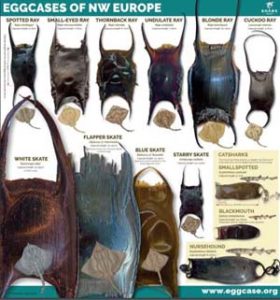
The Shark Trust in the UK has been developing very good identification. guides for sharks, skates and rays in the north east Atlantic for many years now, and we recommend downloading their resources if you are trying to identify mermaids’ purses in a European country with an Atlantic coastline. This includes an Eggcase Identification Guide and an Identification Key for North West Europe.
Peter Bor’s website also provides pics of skate eggcases from Holland. You can also check out Ireland’s egg-laying sharks and rays in our Ocean Animal Fact Files.
Mediterranean Europe
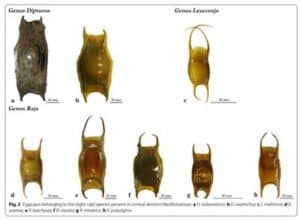
We haven’t been able to find any citizen science eggcase guides for Mediterranean species that have been developed with a public audience in mind. However, If you’d like to delve deeper into some scientific studies, check out Cristina Porcu’s work in the Central West Mediterranean. Herself and her team have described eggcases from skate species in Sardinia, providing detailed descriptions in a paper which was published in the Helgoland Journal of Research.
Fabrizio Serena has also produced a field identification guide for sharks and rays in the Mediterranean and Black Sea, which includes photos of some eggcases (note that it’s quite a large document and you’ll need to skip right to the end of it to see images of eggcases).
Identifying Mermaids’ Purses in Africa
South Africa
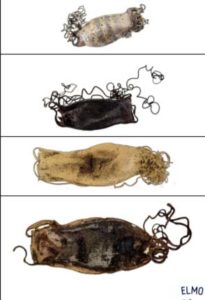 The South African Elasmobranch Monitoring scheme (ELMO) have developed a useful shark and ray eggcase identification guide and key for citizen scientists identifying mermaids’ purses in South Africa. The group also run a shark and ray eggcase sightings scheme for the region and you can report your sightings on their website.
The South African Elasmobranch Monitoring scheme (ELMO) have developed a useful shark and ray eggcase identification guide and key for citizen scientists identifying mermaids’ purses in South Africa. The group also run a shark and ray eggcase sightings scheme for the region and you can report your sightings on their website.
Identifying Mermaids’ Purses in North America
USA and Canada – Northwest Pacific coastlines
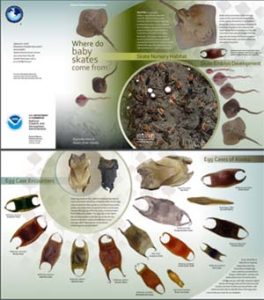 Gerald Hoff, a fisheries biologist in the Alaska Fisheries Science Center, has put together a nice species identification guide for shark and ray eggcases in Alaska. The group are also interested in hearing about sightings of eggcases on beaches along the Northwest Pacific coastline in Oregon, Washington, Canada and Alaska.
Gerald Hoff, a fisheries biologist in the Alaska Fisheries Science Center, has put together a nice species identification guide for shark and ray eggcases in Alaska. The group are also interested in hearing about sightings of eggcases on beaches along the Northwest Pacific coastline in Oregon, Washington, Canada and Alaska.
If you’re interested in delving deep into the scientific descriptions, check out Ebert et al’s paper on skate eggcases in the Eastern North Pacific.
Canada – North West Atlantic coastlines
There are a number of research groups on Canada’s east coast who have been focusing on egg-laying sharks and rays.
WWF Canada have produced a comprehensive Guide to Sharks, Skates, Rays and Chimaeras in Atlantic Canada which includes a key to shark and skate eggcases, while Jim Simon, a marine biologist in the Population Ecology Division in the Bedford Institute of Oceanography, has also developed a useful species identification key for skate eggcases in Nova Scotia.
Marine biologist, Carolyn Miri, is also running a mermaid’s purse sightings scheme in the Department of Fisheries and Oceans in St. John’s.
Identifying Mermaids’ Purses in South America, Central America and the Caribbean
South West Atlantic coastlines
We haven’t been able to find any eggcase identification guides pitched at citizen scientists in South America, Central America or the Carribbean. However, Ezequiel Madragana and his team in the National University of Mar del Plata have published a useful scientific paper on the eggcases of sharks and rays in Argentina. This study includes an identification key and descriptions of eggcases for a number of species in the South West Atlantic. Again, this is really for those of you who feel the urge to delve deep into the world of marine science!
A baby shark in its eggcase, which was filmed in deep water off Puerto Rico and the US Virgin Islands by a team of scientists from NOAA (Office of Ocean Exploration and Research).
Identifying Mermaids’ Purses in Asia
According to Peter Bor, skate eggs are reasonably well studied in Japan. His site provides a number of images of Japanese skate eggcases produced by Izumi Hanno. You can also read about White Spotted Bamboo Shark eggcases in this article by the New England Aquarium.
Identifying Mermaids’ Purses in Australia and New Zealand
Although we haven’t been able to find any identification guides specifically targeting a citizen scientist audience, there is an interesting article in the Australian Geographic by Angel Heathcote that describes some of the shark and ray eggcases in Australia. Mark McGrouther in the Australian Museum has also written an informative article on the Port Jackson Shark which includes information gathered through citizen science sightings.
A scientific paper by Treloar et al describes eggcases from egg-laying skates and rays in Southeastern Australia. According to Peter Bor, Gilbert Whitley has also done great work on the Australian eggs of sharks, skates and elephant fish (Holocephali).
Although there appears to be little information available online for mermaids’ purses in New Zealand, you can view images of eggcases from some shark and ray species on The Otago Museum’s website.
Step 4: Verifying your species ID with a local shark eggcase sightings scheme
 Once you are happy that you have identified your mermaids purse samples, you can then verify your species identification by contacting the Shark and Ray Eggcase Sightings Schemes for your region. Scientists will then include your record in their database so that it can inform fisheries conservation management for egglaying sharks and rays.
Once you are happy that you have identified your mermaids purse samples, you can then verify your species identification by contacting the Shark and Ray Eggcase Sightings Schemes for your region. Scientists will then include your record in their database so that it can inform fisheries conservation management for egglaying sharks and rays.
You may also come across species that are difficult to identify, even for a specialist. For example, the Undulate Ray and Spotted Ray eggcases in the north east Atlantic are very difficult to tell apart, especially when the eggcases are the same size. You will most likely need the help of an expert to confirm identification for these species.
It’s also good to get some guidance from a specialist, just to make sure that you are on the right track. The marine biologists will likely give you some background information on the species that you have recorded too which makes it all the more interesting, and with time and practice, you may well become a bit of an expert too!
